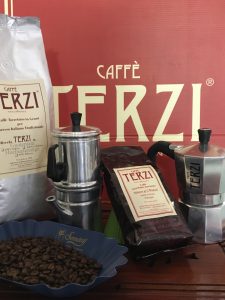
Alfonso Bialetti in 1933 had the classic stroke of genius looking at the women who did the laundry on the pot boiling on fire: he thought in fact to apply the same principle to the preparation of Coffee.
A boiler with boiling water that, by the pressure of its vapor, ascends a duct, then has to pass through a filter containing ground Coffee: this sums up the simple idea drawn up by our moustached Alfonso, whose caricature for decades has been drawn on the Italian coffee pot.
That’s how in 1933, in his company specialized in aluminium articles, founded in 1919, Bialetti began producing the mythical coffee pot with the moustached man. Originally 100% aluminium, it is today considered the Italian coffee pot par excellence, especially in the North and Center of Italy. For decades, Moka’s mumbling with boiling Coffee accompanied the awakening of adults preparing for the working day, but also generations of children and teenagers in need of a revitalizing awakening to better face fatigue and school engagements.
It happened the same to me! And even today I’ve got the same interest and passion for Moka. Indeed, I think that Caffè Terzi first defined the parameters for the preparation of a good Moka, in the belief that, putting into effect some simple arrangements, we can achieve results beyond expectations!
Let’s see them together:
– Very first essential rule: good quality Coffee and possibly ground two or three minutes before use
– Fill the filter with a slightly abundant amount of ground (with a small accumulation in the center of the filter)
– Level the ground to distribute it homogeneously throughout the filter and remove any excess, using, for example, the back of a straight blade and sliding it down on the filter
– Preheat the bottom of the boiler with boiling water that will be thrown immediately after
– Heat apart good quality mineral water at a temperature close to boiling
– Fill the boiler until the water reaches the safety valve with the hot mineral water
– Tighten the coffee pot to the boiler (we call “coffee pot” the top with the nozzle and the lid set up on the boiler, which is the bottom with the water); OPEN THE LID AND LEAVE IT ALWAYS OPEN
– Put the Moka on the rather high flame but not so much that it envelops the sides of the boiler
– After a few moments pour COLD water (two or three spoons) into the coffee pot. Just enough to form a circular “ring” on the bottom. It will be used to absorb the heat of the metal, preventing it from overheating too much and preventing also the first drops of extracted beverage from burning. This will help you to give more pleasantness to Coffee.
– As soon as you can see the cream coming out, clear signal that Coffee is coming out, immediately lower the flame to have a fluent and continuous flow until the end
– When the level of the drink reaches the spout attachment into the coffee pot, remove the Moka from the gas. Thermal inertia will continue the extraction WITHOUT LETTING THE COFFEE BOILING: COFFEE MUST NOT BE ALLOWED TO BOIL!
– Wait for 20/30 seconds, then stir and serve the Coffee.
The extraction must be fluent and continuous, from the beginning to the end; apart from avoiding the boiling, the spillage of the drink must not splash or suddenly stop.
We talked about good quality mineral water: which is the best?
There is no very best water, but we can choose: if we use a slightly alkaline water, perhaps carbonated-calcium water with a medium fixed residual, we will probably obtain a more balanced beverage from the acids/tannins point of view (or slightly more tannic), softer, more fragrant and sweeter; if we use a fresh water (low hardness), with low fixed residue, and possibly acidic (pH <7), we will have a more aromatic and cooler drink, probably slightly less “persuasive” and less “enticing”, more liquid, but wider, more fragrant and more complex and, because of its acidic pH, we will have a better “stability” over time and a slower oxidation, resulting in a slower rancidity of our beloved drink that we can so sip quietly, as a real meditation drink.
We will have to wash and clean the Moka immediately and every time we use it, by removing all the residues of Coffee all around the coffee pot. Then, we must rinse the Moka, exclusively with warm water and no detergent, and finally mechanically clean with our fingers all sides in contact with the drink, to remove all the oils and colloids that form an greasy film that time after time would tend to oxidize and turn rancid, making the Coffee of next preparations unpleasant.
From time to time, the plastic gasket in the lower part of the coffee pot should be taken off, the circular flat filter secured by the same gasket should be removed and then, with a brush, we should clean off the deposits caused by the use, the torch from which Coffee comes out.
Good Coffee everybody!
